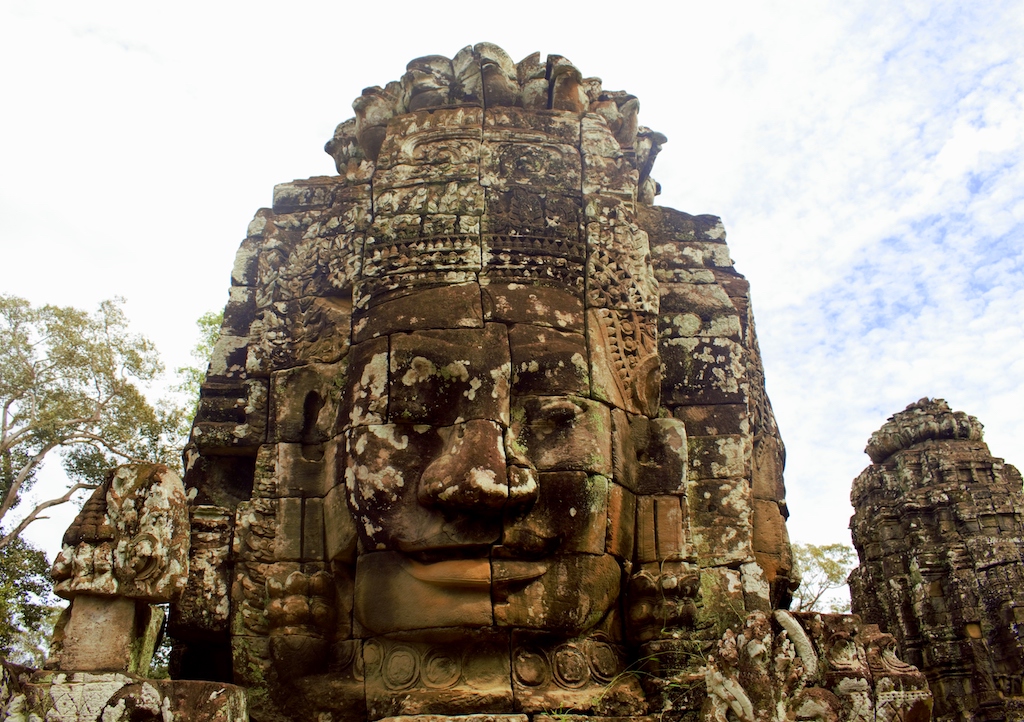
Table of Contents
Bayon Temple in Cambodia – The Smile of Angkor
The sky was awash with brilliant colors. Red, blue, green, it seemed like all the colors of the spectrum had split and exploded in Kaleidoscopic brilliance. But it was not the sky that riveted the attention. It was a colossal face with an enigmatic smile that looked down at us from a lofty height. A mammoth face cut in black stone and exuding a supernatural aura. The scene that stretched out was surreal and like a dream. It was actually an early morning dream, dreamt in Cambodia. We were in Siem Reap and the day promised to be one of the best in our lives, starting with viewing the sunrise at Angkor Wat. But what really was an experience that gave us goosebumps was when we stood in front of the Bayon temple in Cambodia.
The Bayon Cambodia – Exploring The Treasures of Siem Reap
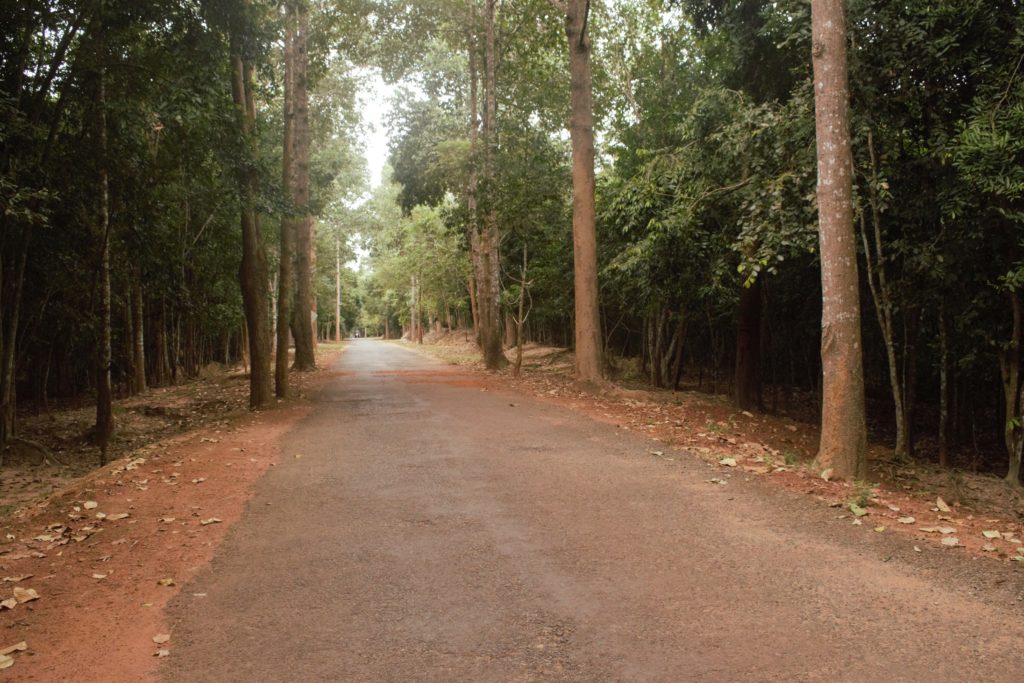
Excitement surged within us as we drove from Siem Reap towards the Angkor Archaeological Park. We looked forward to a day that promised to be out of the world as we looked forward to exploring the treasures of the Kingdom of wonders. We had two days in Siem Reap and hoped to see the main temples of this world famous heritage site. Our guide Sovithyea Hok had charted out our itinerary for the day and the morrow. He had used his experience to chart a course that followed a pattern diametrically opposite the ones followed usually by tourists.
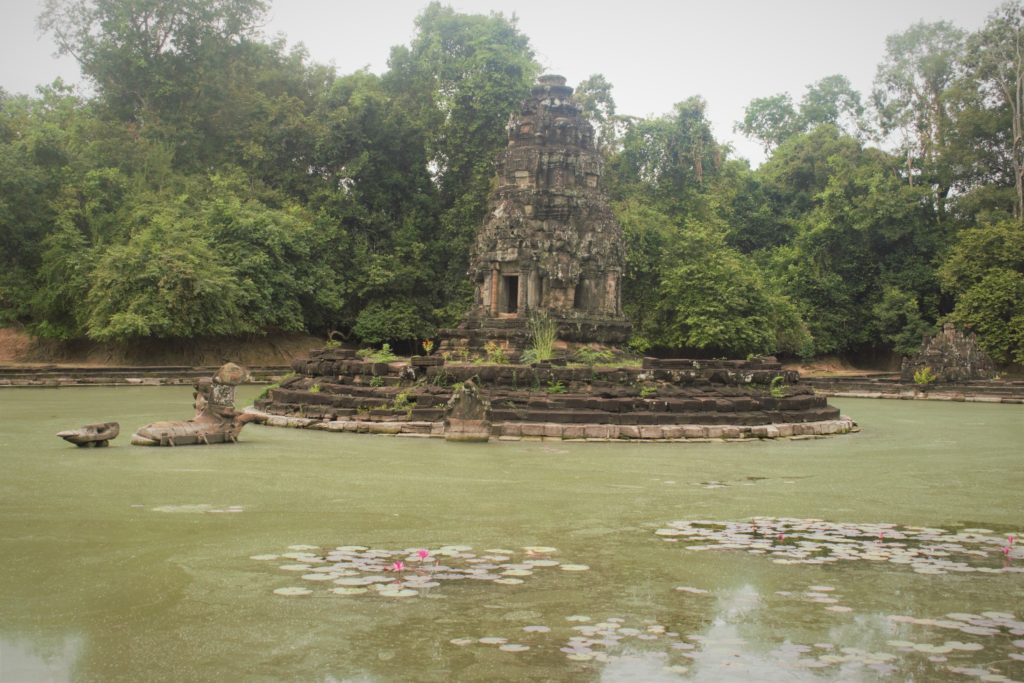
The day began with a visit to a small but fascinating little temple known as Prasat Neak Pean. A narrow path in the midst of a big pond with colorful lotus flowers floating on either side leads to the 12th-century temple with many ponds. The temple is believed to have been a hospital of sorts with the waters providing healing for various ailments. From here we headed towards the ancient city of Angkor Thom which translates as, “The Great City”. Within this city, lies one of the most famous and enigmatic temples, the Bayon Temple in Cambodia. The temples of Angkor Wat, Bayon, and Ta Phrom are sometimes referred to as the big three of Siem Reap.
Bayon Angkor – The Angkor Thom Gates
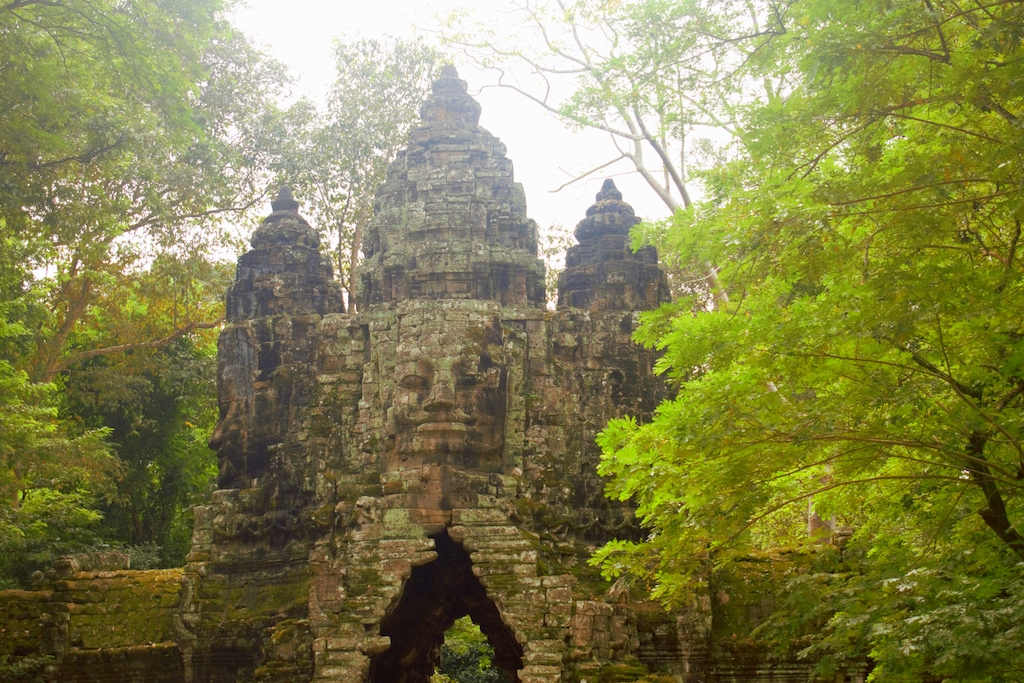
We entered the city of Angkor Thom from the northern gate. Most if not all tourists enter from the southern gate which is in much better condition as compared to the others.
We experienced an eerie feeling as we stood in front of a gate which in terms of dimensions was not more than 3.5 m by 7 m. The gate was surmounted by a huge tower towering 23 meters in height. But what had our gaze transfixed were the four smiling stone faces that looked down benignly at us.
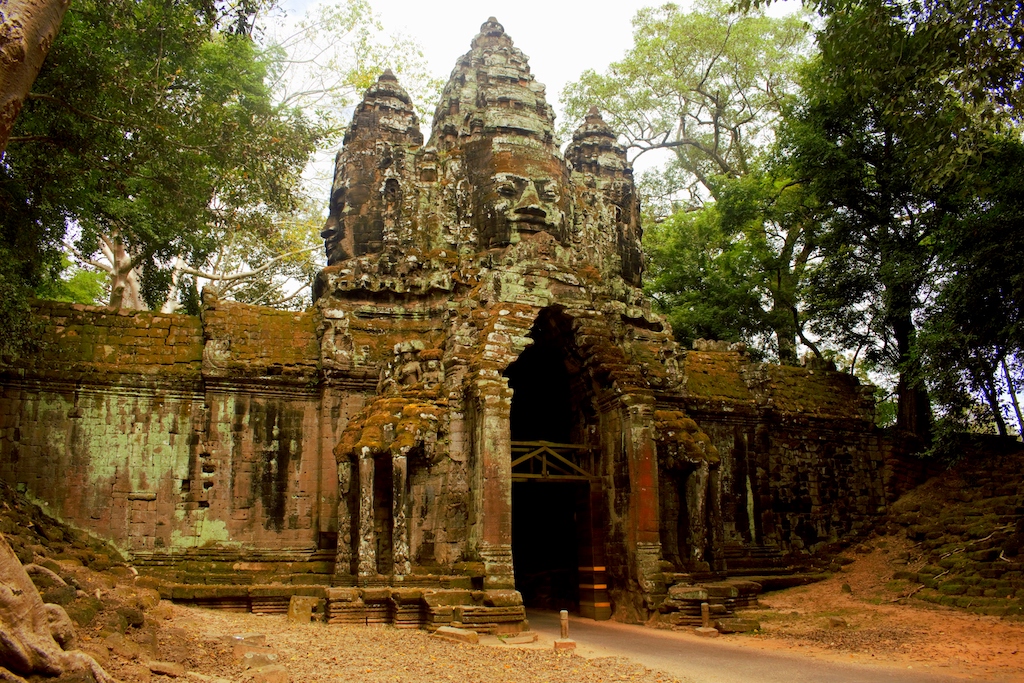
A sense of deja vu enveloped us as we recalled the early morning dream. But we realized that this was just a small preview of larger things to come that awaited us at the Bayon temple in Cambodia.
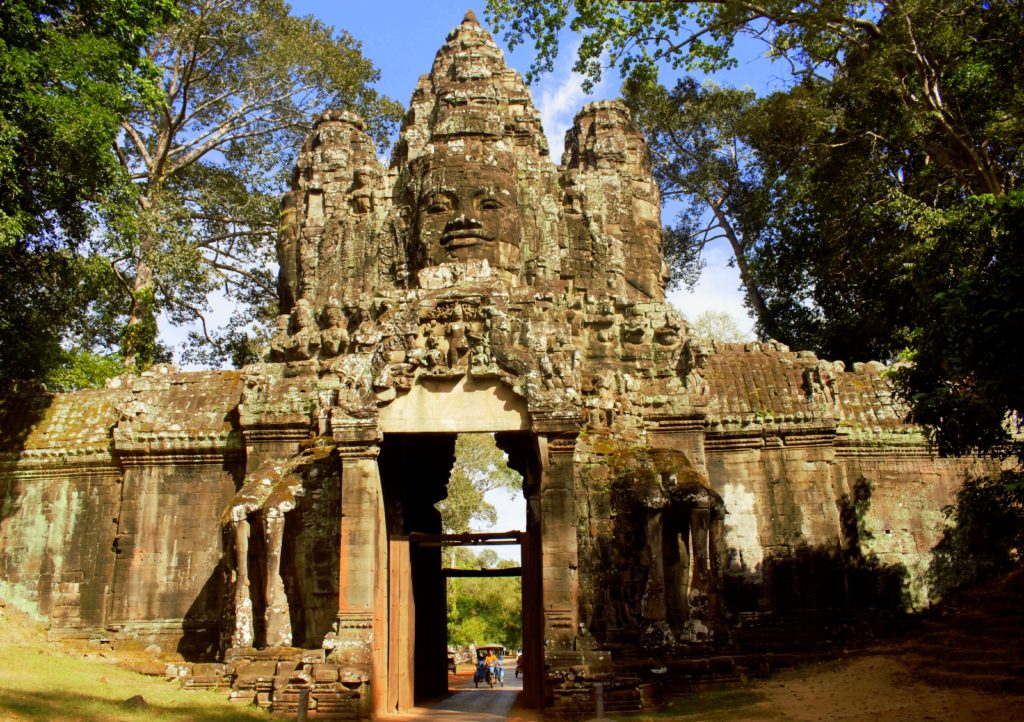
“There are a total of 5 gates that allows entry into the city of Angkor Thom”, said our guide Sovithyea Hok. He mentioned that there are 4 gates, one each at all the cardinal points. On the eastern side, there is an additional gate.
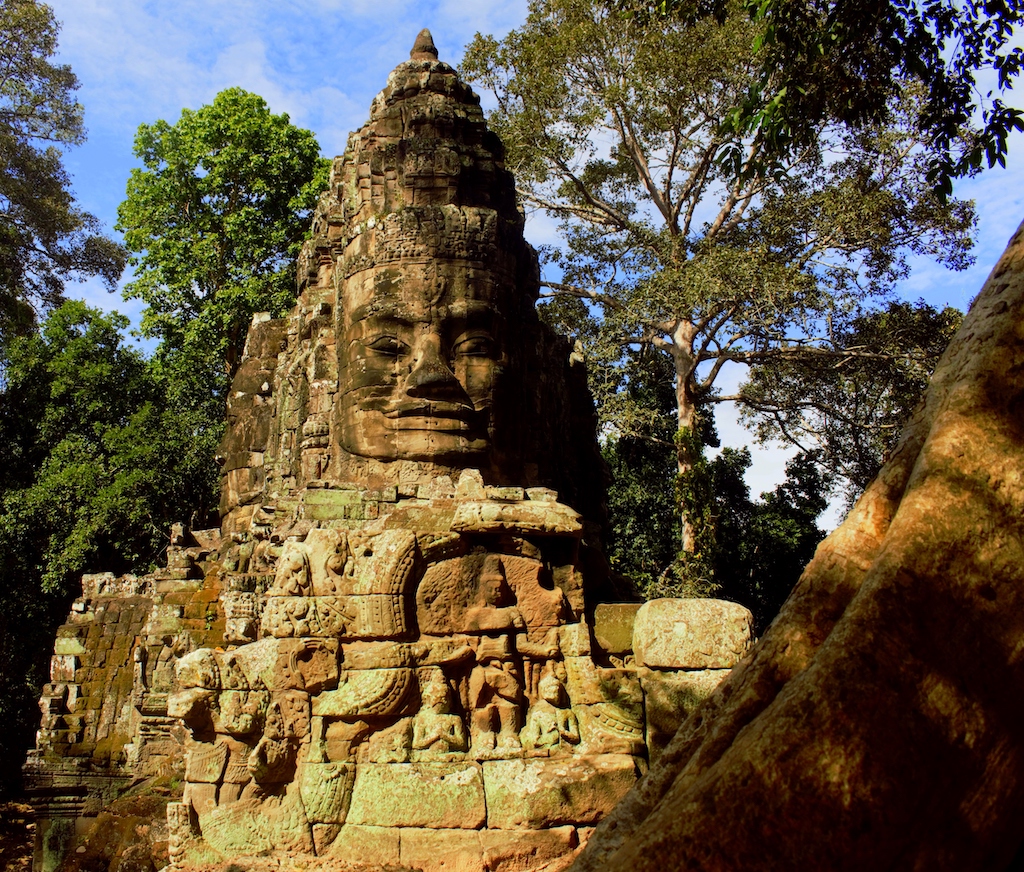
The eastern side has two gates named as Victory Gate and Death Gate. All the gates have towers that are identical with four faces presumed to be that of the Bodhisattva Avalokiteshvara. The gates were most probably closed with wooden doors when the city was a thriving urban center. The gates have moats in front with a causeway that spans each of them.
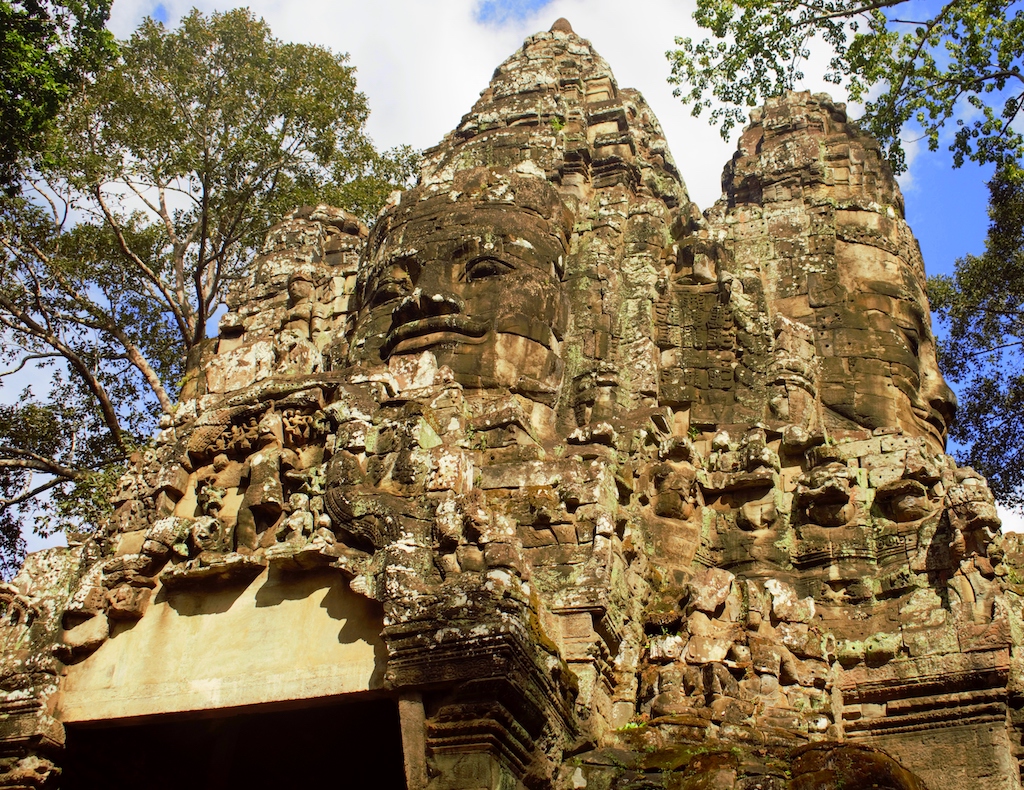
The gates to Angkor Thom are built into an 8-meter high wall. The wall completely encloses the city of Angkor Thom and forms a square. The area that this wall encloses is 9 square kilometers. The ancient city of Angkor Thom is said to be the last of the great cities of the Khmer Empire before falling into decline forcing the Khmer empire shift base towards Phnom Penh.
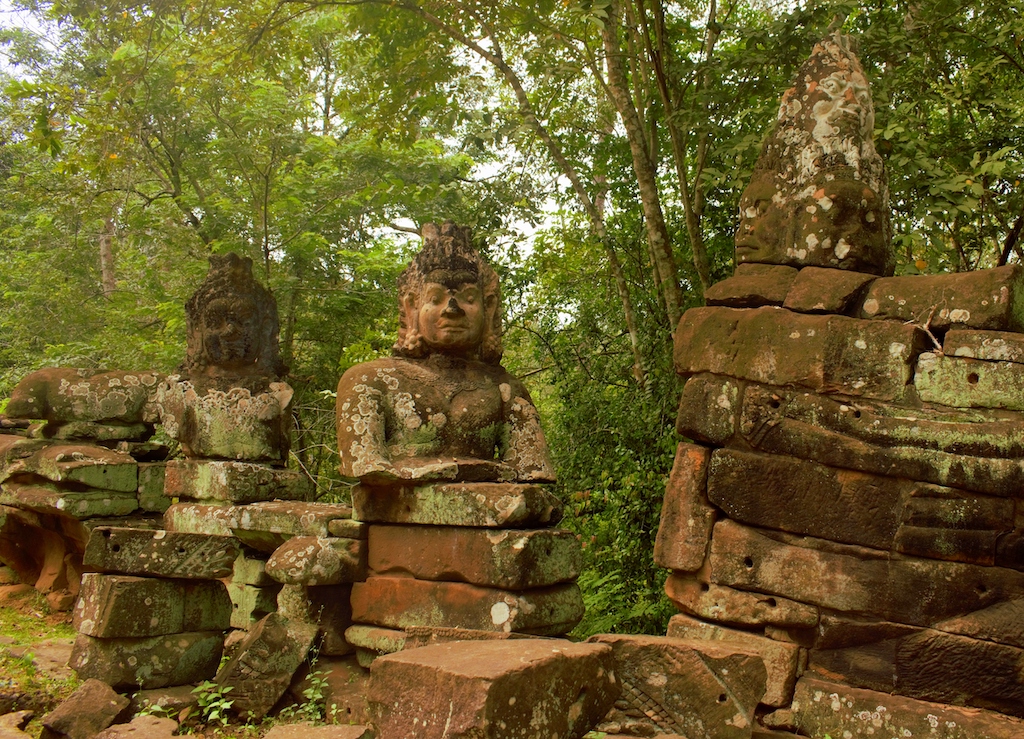
On the path leading to the gates on either side, there were statues holding a naga. On one side were the Devas or the Gods and on the other the Asuras or demons. This is a motif from Indian mythology called the “Churning of the Ocean”.
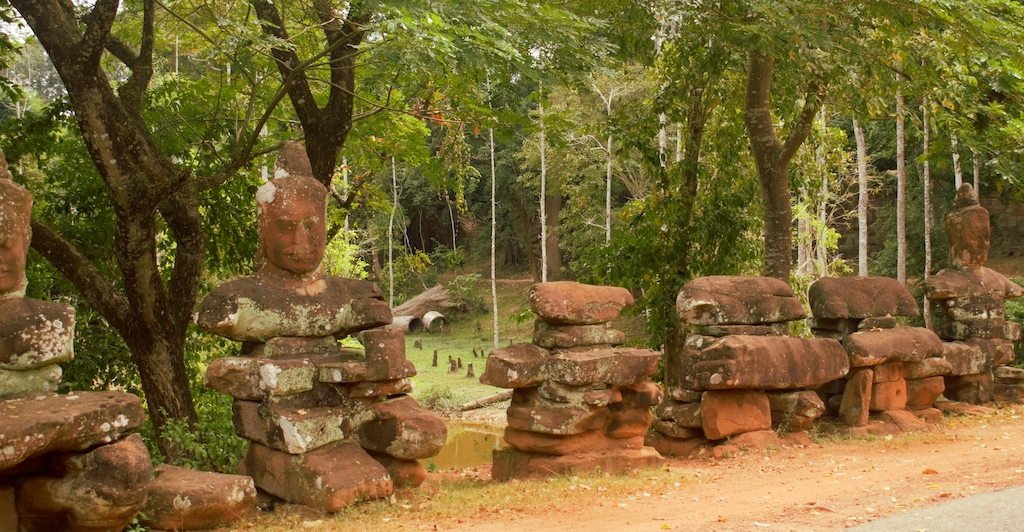
Unfortunately, the statues are broken completely in most of the gates. The southern gate is where one needs to head to for a glimpse of the statues of the devas and asuras. But when you are in Siem Reap, the churning of the ocean, is something that you will come across in almost all the temples. If you visit the temple of Preah Khan, the gate leading to the temple has similar statues on either side. The Naga and the churning of the ocean motifs can be seen in temples across Siem Reap and Cambodia, we found them when we were in the temple of Phnom Da and Phnom Chisor in the Takeo Province too.
Face To Face With The Smile of Angkor – Angkor Thom Bayon Temple
The Angkor Thom city is remarkably symmetrical with perfect proportions. Though you may not realize it on the ground, if you view an Angkor map you are sure to marvel at the skills of the engineers and architect who planned and built the city.
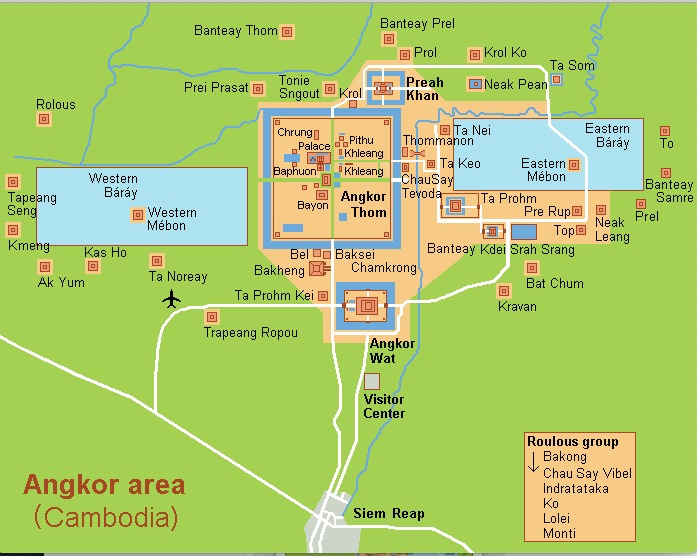
All roads in Angkor Thom seem to lead to the center where lies the spectacular Bayon temple Angkor Thom. The roads that lead from the gates on each cardinal direction converge at the center point of the square which happens to be the Bayon temple. Though the gates were built much later than the Bayon temple. It is believed that the temple was the epicenter of the city.
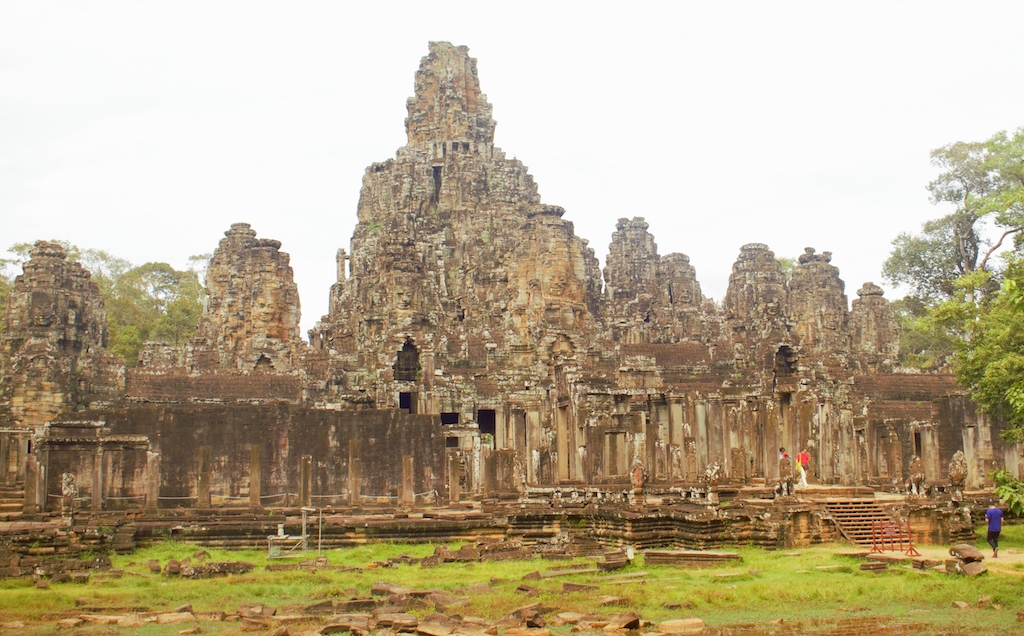
From a distance, the Bayon temple failed to impress us. It looked like an indistinguishable mass of black. Probably because of the play of dark color of the stone and the bright afternoon light. But as always appearances are deceptive. We walked towards the Bayon temple and as we got closer and closer, our hearts beat faster. Soon we saw the giant stone faces, multiple of them smiling at us from all conceivable angles.
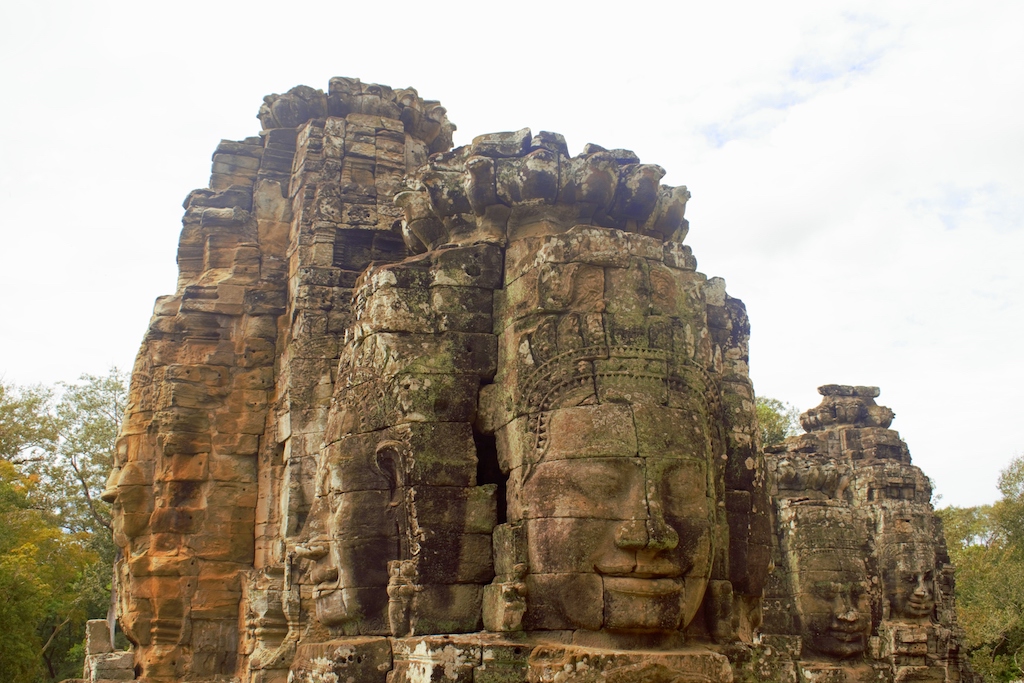
The sheer magnitude of these stone faces hits you. As you get closer to the stone faces which are on the third level of the Bayon temple, a feeling of awe coupled eerieness envelops you and climaxes when you are on the same level as the stone faces.
The Mystery of The Smiling Faces of Bayon
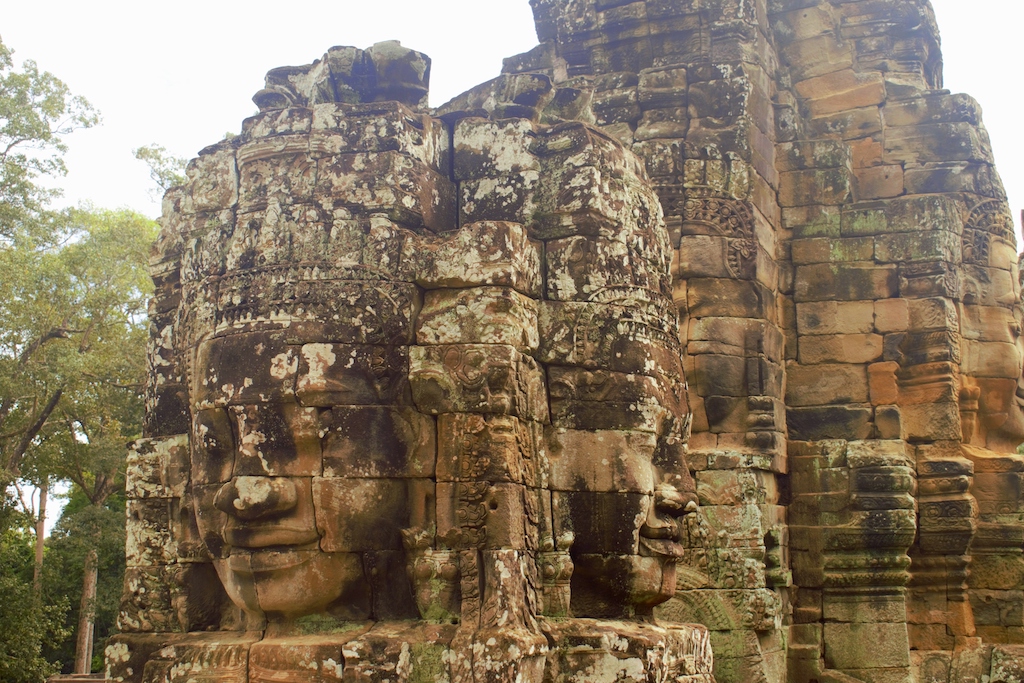
The Bayon temple faces are one of the most well-known metaphors for Cambodia apart from the Angkor Wat temple. But who do the Bayon temple smiling faces represent? How many faces does the Bayon temple have? These are questions that pop up in your mind as you stand in front of one of the most amazing ancient spectacle of the world.
Our guide explained to us that there were 54 towers built on the top level of the Bayon temple. Each tower had 4 each of the famous Bayon faces that looked towards the four cardinal directions. Thus making a total of 216 of the Bayon temple smiling faces. Out of these time has taken a toll of some of the towers, however about 200 faces still survive, shrouded in an aura of mystery and intrigue.
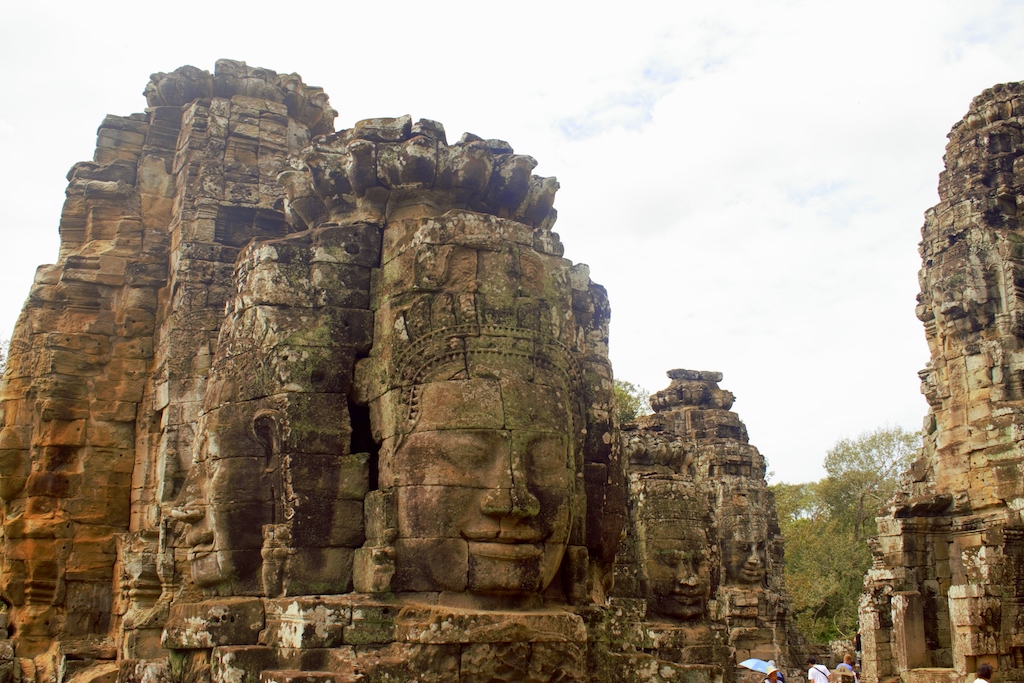
It is not crystal clear whose face the 216 faces of Bayon represent. it is generally believed that the faces are depictions of the serene face of the Bodhisattva of compassion, Avalokitesvara or Lokesvara. Others believe that the faces of Bayon actually represent the face of King Jayavarman VII, who like some of his predecessors may have equated himself with God and built the Bayon temple as the ultimate expression of megalomania. The resemblance of the features of the King Jayavarman VII with the stone faces of Bayon lends some credence to this theory. However, the generally accepted theory is that the smiling faces of Bayon are indeed that of Avalokitesvara.
Whoever the enigmatic faces of Bayon may represent, their sheer size and enigmatic countenance are sure to make you feel what an insignificant part of the universe you are. Probably one of the objectives of the massive proportions used in the Bayon style of temple architecture is to deflate the egos of mankind.
Bayon Temple History
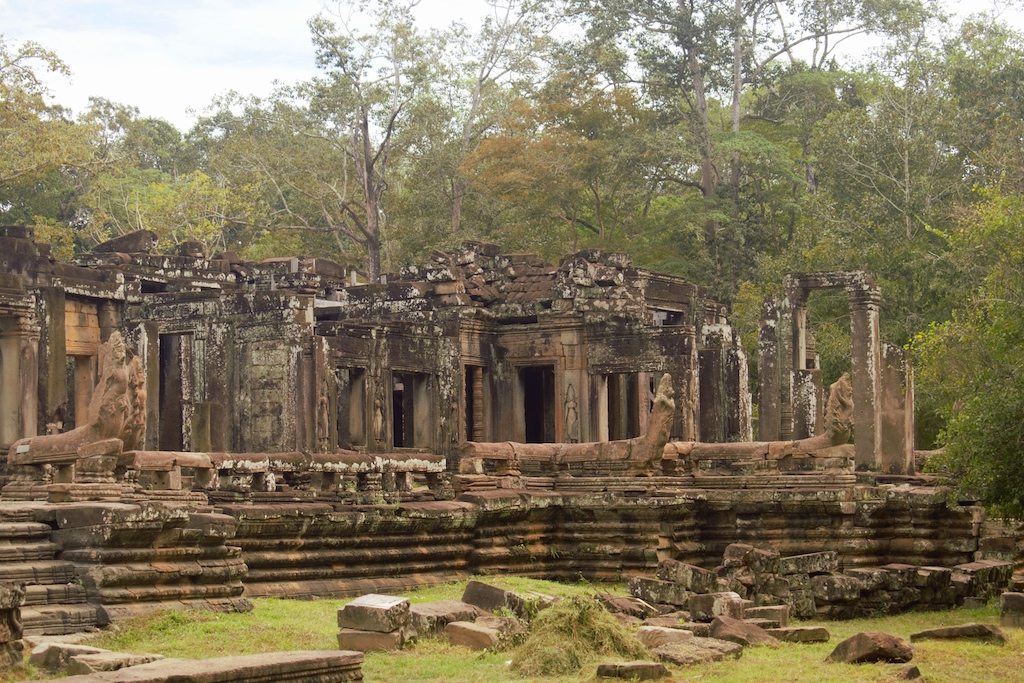
The Prasat Bayon or Bayon temple Siem Reap was built in the 12th century. The credit for building the Bayon goes to one of the most notable kings of the Khmer Empire, King Jayavarman VII. The importance of the Bayon temple lies in the fact that it was probably the last state temple built in the region. It was also the only temple that was mainly dedicated to the Mahayana discipline of Buddhism. King Jayavarman VII was a Buddhist as opposed to many of his predecessors who were Hindus. Jayavarman VII successors reverted to Hinduism which was again followed by Theravada Buddhism.
This change in religious allegiance over time is reflected in the temples of Angkor Thom as well as in Angkor Wat and other temples. The boundaries between Hinduism and Buddhism seem to fade as one walks around the temples. Hindu symbology and mythology rub shoulders with the Bodhisattvas at every nook and cranny.
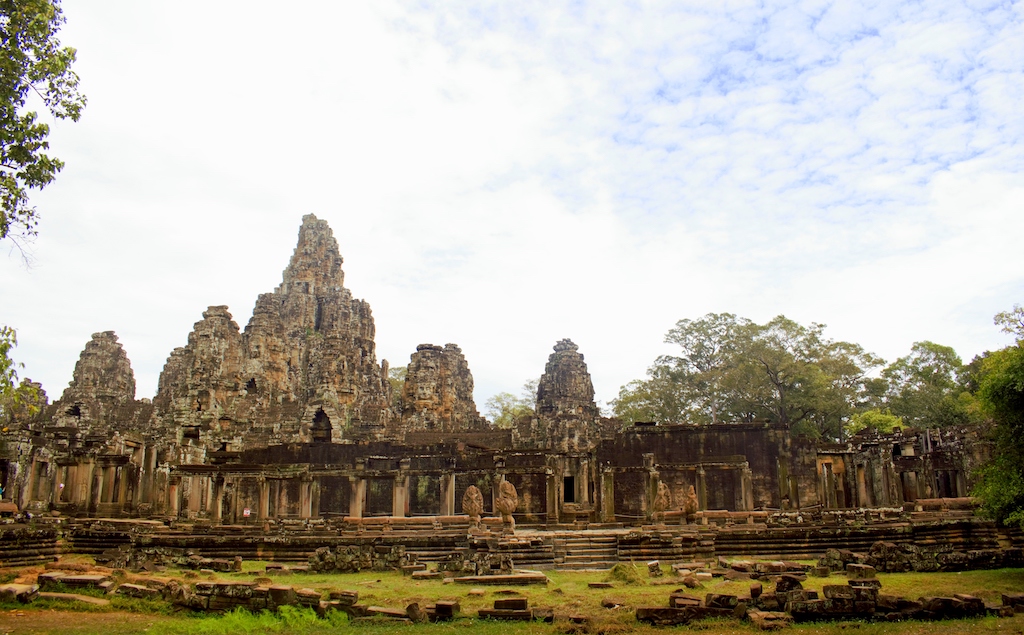
The Bayon temple was originally known as Jayagiri which literally means Victory Mountain. After it was discovered during French rule in Cambodia, it came to be called as the Banyan temple. This could be because it was a Buddhist temple and the French equated it to the Bodhi or Banyan tree under which Buddha got enlightened. As restoration work on the ruins of the Bayon temple got underway and the local Khmer people got involved, the name Banyan slowly got metamorphosed into Bayon. So today, it is the Bayon temple that stands as a smiling enigma in stone, some refer to the faces of Bayon as the Mona Lisa of the east too.
The Bayon Temple Layout And Architectural Design
The Bayon temple is built in what has been named as the Bayon style of architecture. In the latter part of the 12th century, King Jayavarman VII embarked on a major spree of construction. The temples he built during this period were gigantic in scale and the Bayon temple stands as a towering monument to this architectural style. It may be noted that the Bayon style though spectacular in proportions lacked the perfection of what is known as the classical or Angkor Wat style of architecture.
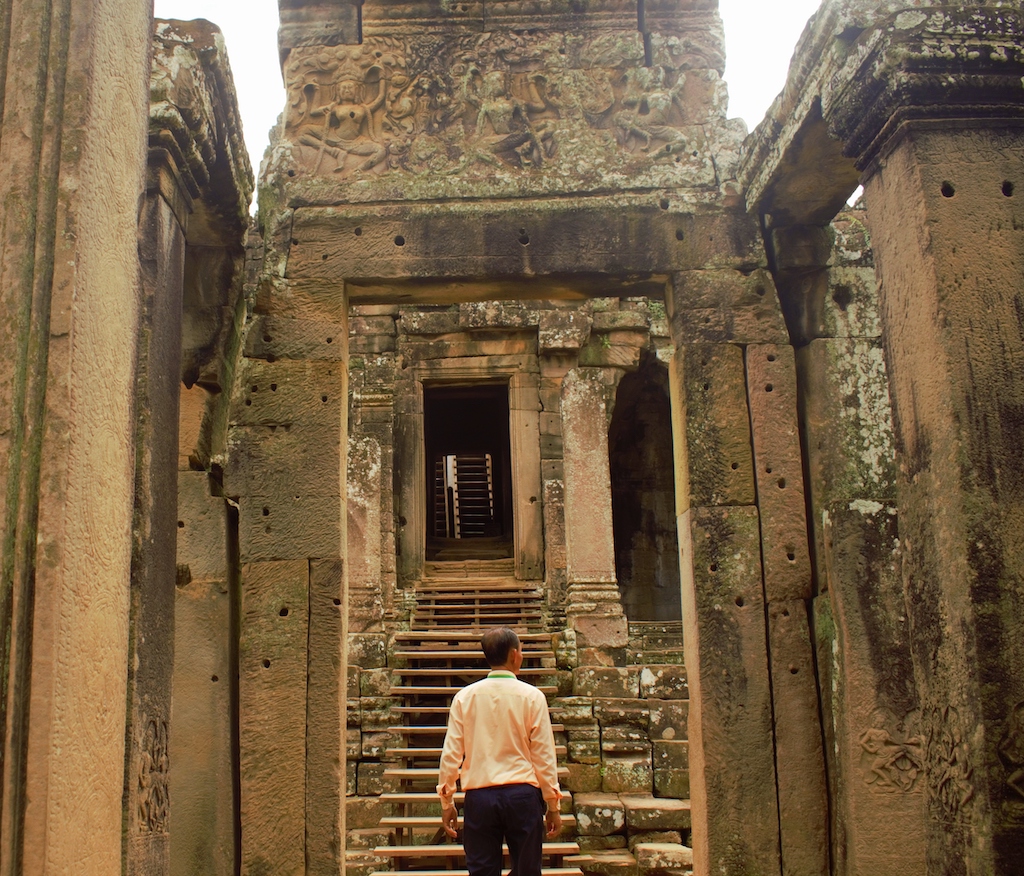
The Bayon temple does not give you the feeling of immense spaces around you like the temple of Angkor Wat. In fact, it wraps around you in claustrophobic proportions and gives the impression of too much being compressed into too little space.
The Bayon temple structure primarily consists of an outer gallery, an inner gallery, and the upper terrace. The temple does not have an outer wall or moat and stands bang in the center of Angkor Thom. It is believed that the square wall which encloses Angkor Thom along with the gates in the cardinal directions are actually a part of the Bayon temple itself. If that is the case then the area of the Bayon temple complex at 9 square kilometers would be more than the area of the Angkor Wat complex.
The Outer Gallery of Bayon Temple
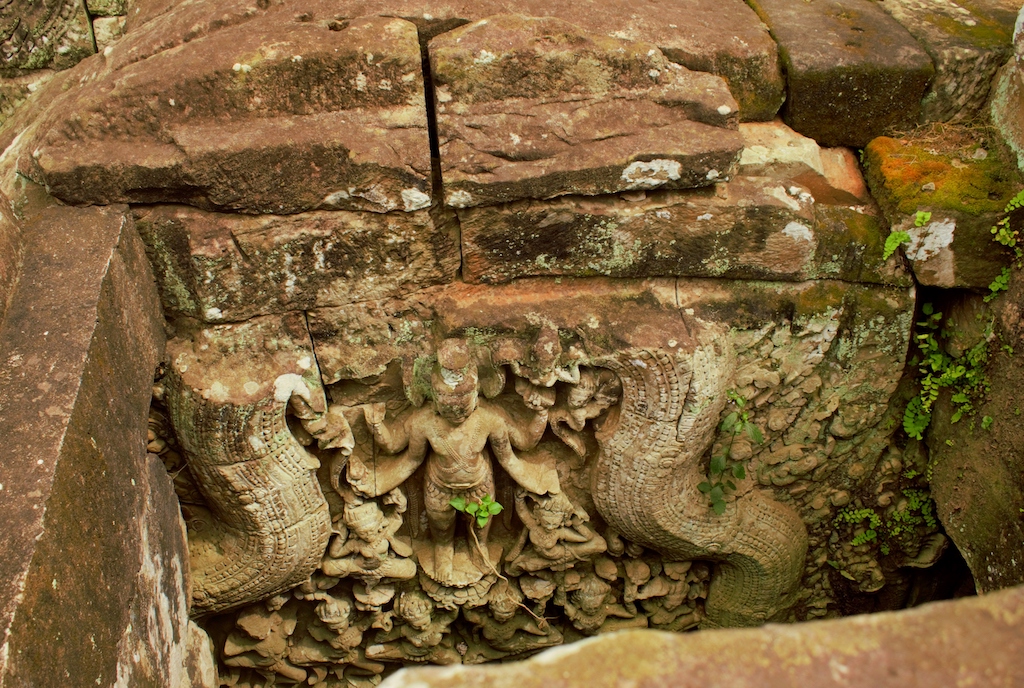
The outer gallery of the Bayon temple in Cambodia has Bas reliefs depicting scenes from the everyday life of the people. It has also scenes of military warfare, games of the times like cockfights and wrestling, hunting scenes, etc.. Two libraries also were part of the outer gallery.
The Inner Gallery of Bayon Temple

The Inner gallery has Bas reliefs depicting various scenes from Hindu mythology. Many of the scenes depicted seem disconnected and there is speculation about them. Some scenes are linked to the Leper King of the Khmer Empire who is said to have contracted leprosy after being bitten by a serpent.
The Upper Terrace And The Towers of Bayon
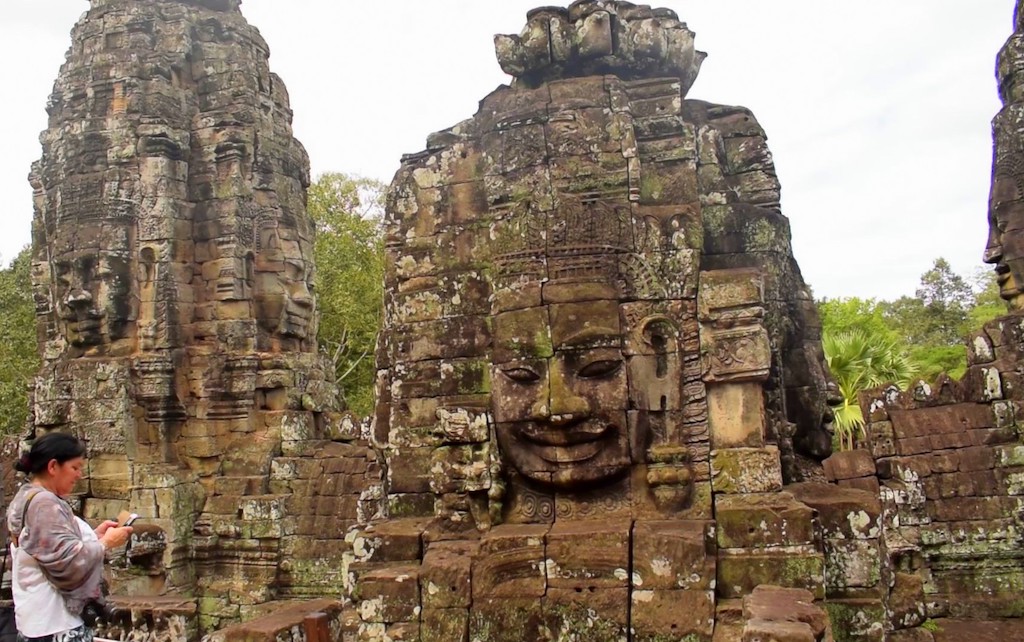
The upper terrace which is actually choc a bloc with the inner gallery gives the impression of being an afterthought. It may have not been in the original plan of the temple and could have been a later addition. Whatever it may be, it is the upper terrace that grabs eyeballs of anyone who comes in the vicinity. 200 stone faces look in all the four directions from here.
The upper terrace is home to the towers which originally were believed to have been 54 in number. It is also believed that there were additions to the number of towers and also depletion when some towers bent to the ravages of time. As you move around the temple you feel as if you are looking into mirrors skilfully placed so that you see multiple images of the stony and yet serene face of Avalokiteshvara. They are there everywhere, whichever direction you turn, you are sure to see the face of the Bodhisattva of compassion.
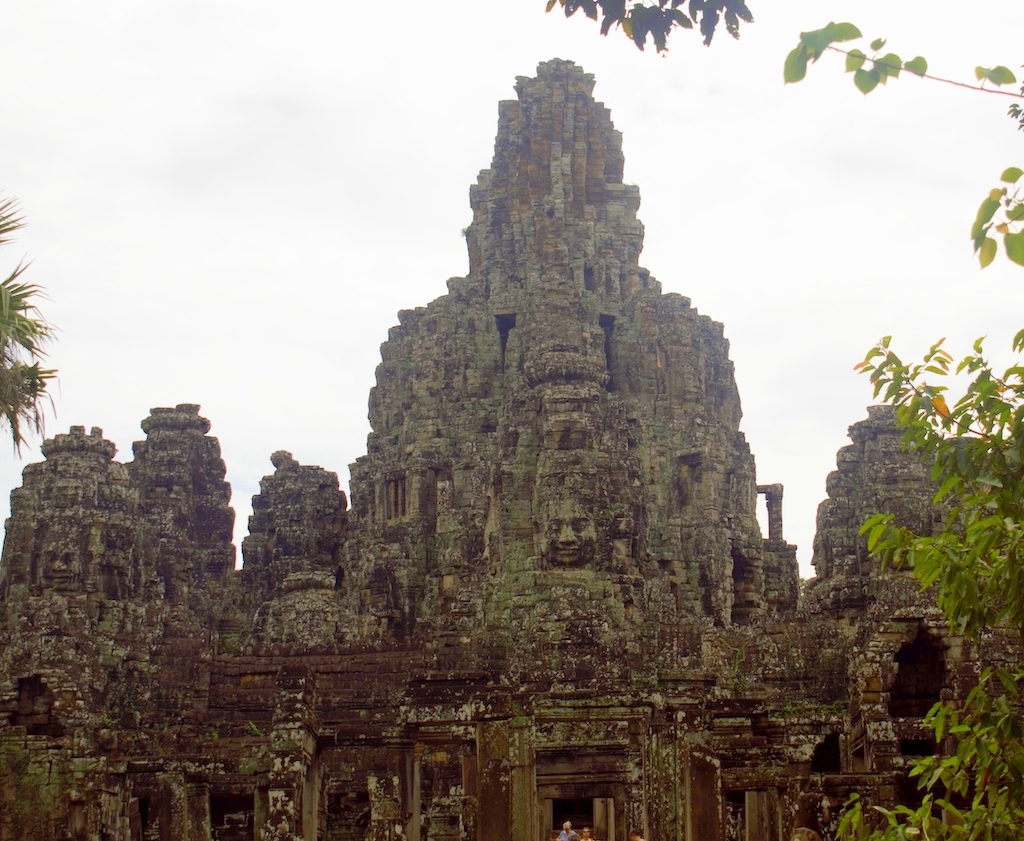
The upper terrace consists of a central tower surrounded by other towers. It is said that beneath the central tower inside the sanctum there existed a statue of Buddha sitting in meditation with the hood of the serpent Mucalinda protecting him from the elements. But the statue is said to have been destroyed and thrown into a well by King Jayavarman VIII who had embraced Hinduism. The statue, however, was recovered and restored by the French and presented to the then King of Cambodia, His Majesty Sisowath Monivong in the year 1935. The statue now is located in a special pavilion on the southern side of the road that leads to the Victory Gate in Angkor Thom.
The Bayon temple was constructed primarily as a monumental dedication to Buddha and as a statement of the power of King Jayavarman VII himself, fresh after his vanquishing the Chams in war. Though dedicated to Buddhism, the temple, later on, acquired shades of Hinduism too as is evident from the Bas reliefs.
Today as you enter the outer gallery of the Bayon temple, you do feel boxed in by the narrow corridors and doors that snake through the temple. The absence of natural light adds to the feeling of being cramped. However, as you emerge into the upper terrace, a feeling of serenity and peace overcomes you as you stand in the midst of the gigantic and yet benign faces that look at you with the hint of a smile.
Tips For Visiting The Bayon Temple
- The best time to visit the Bayon temple is early morning to beat the crowds
- As the Bayon temple is oriented on the Eastern axis, the Bayon faces acquire an ethereal radiance during sunrise
- Like all temples in Siem Reap please be ready to do some amount of walking and climbing, the narrow and steep stairways and passages can be a little challenging for those not physically fit and the aged
- If you looking for a leisurely visit to the Bayon temple plan for at least 2 hours though you can breeze through in about 45 minutes
- You require the Angkor temple pass to visit the Bayon temple
- The Angkor temples Pass can be bought for a single day, for three days, or for seven days from the Angkor Enterprise Ticket Office managed by the APSARA Authority
Bayon Temple FAQ
When was the Bayon temple built?
The Bayon temple was built in the 12th century by the Khmer king Jayavarman VII.
Why is the Bayon temple important?
The Bayon temple Cambodia is probably the last of state temples built by the Khmer empire and a paradigm of the Bayon style of architecture that it forged.
What is the Bayon temple made out of?
Khmer architecture used Brick, sandstone, and laterite along with wood for the construction of temples. What survives today is mainly the elements of brick, sandstone, and laterite as wooden elements have bitten the dust.
How big is the Bayon temple?
The Bayon temple in Cambodia does not have an outer wall or a nearby moat. It is generally believed that the entire 9 square kilometer city of Angkor Thom is the Bayon temple complex. The moat and wall that surrounds the city is actually part of the Bayon temple. The temple in the center represents the mythological Mount Meru. This is in keeping with the Khmer architectural styles including that of Angkor Wat.
How many temples are in Angkor?
Talking specifically of the ancient capital of King Jayavarman VII Angkor Thom, the main temple is Bayon temple. The other noted temples here is the Bapuhon temple. A temple inside Angkor Thom named Mangalartha is noted for being the last dated Angkor temple. The corners of the city have small temples called Churung. There are a total of about 10 small and big temples within the city of Angkor Thom.
Why was Angkor Thom built?
Angkor Thom was as the Capital of the Khmer empire ruled by Jayavarman VII. The capital also absorbed some parts an earlier capital known as Yashhodharapura. The capital was a part of a major building spree undertaken by Jayavarman VII.
How old is Angkor?
The ancient city of Angkor Thom was built in the late 12th century, while Angkor Wat was built about a century earlier.
Is there a Bayon temple entrance fee?
One can visit the Bayon temple with the Angkor temple pass.
Quick Bayon Temple Facts
- The Bayon temple was built by Jayavarman VII in the 12th century
- The temple is a Buddhist temple but had shrines to Hindu deities Shiva and Vishnu
- The most striking feature of the Bayon temple is its 200 odd smiling faces said to represent the Bodhisattva of compassion Avalokiteshvara
- The Bayon temple is built in the Bayon style of architecture
- The Bayon temple is regarded as the last state temple of the Khmer empire
- The Bayon temple stands at the centre of the city of Angkor Thom and the roads from all the gates lead to it
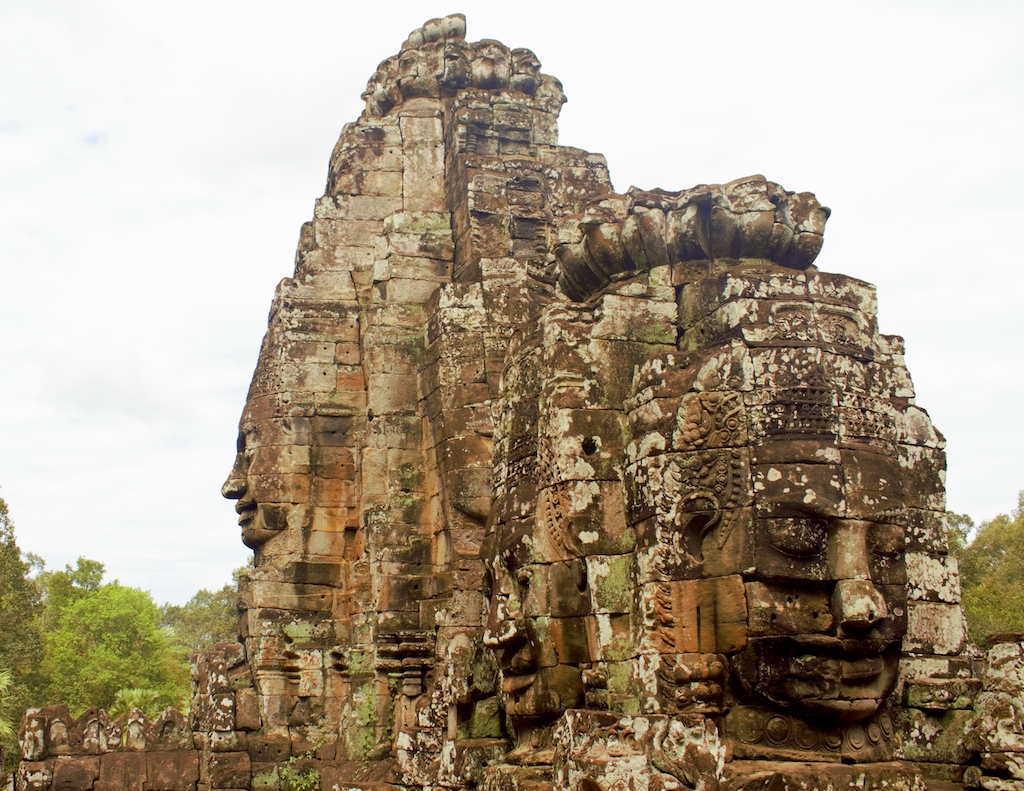
We pause for a last look at the Bayon temple as we head towards the eastern gate to another legendary temple, the Ta Prohm temple, also referred to as the Tomb Raider temple. The enigmatic faces with drooping eyes seem to say farewell to us though not a word escapes from those slightly curved lips. But the stone faces tell a story of a once grand era without uttering a word. Those stone faces have carved a permanent place for themselves in our psyches and continue to haunt us with their enigmatic countenance.
How to Reach Siem Reap
The Bayon temple is located within the Angkor Archaeological Park about 10 kilometers from Siem Reap. To get to Siem Reap do check out some cheap and best options through TripAdvisor or Agoda or CheapAir or Cleartrip or Makemytrip or Priceline.
Where To Stay In Siem Reap
For visiting the Bayon and other temples one can stay at Siem Reap. There are many Siem Reap hotels for all budgets, from homestays and hostels to budget hotels as well as star luxury hotels.
Hotel booking can be done through TripAdvisor or Cleartrip or Agoda or Makemytrip or Priceline to save huge and get the best deals on booking your stay.
| Click to book the best hotel/resort in Siem Reap |
|---|
Siem Reap Tours/Package Tours available in Siem Reap
Siem Reap attractions are many and if you are wondering what places to see in Siem Reap or what to do in Siem Reap, then Siem Reap Tours are available easily. You can now book tours in Siem Reap as well as activities in Siem Reap. Plan the best places to visit in Siem Reap, Cambodia, and experience the Bayon temple and other magnificent temples beyond Angkor Wat.
| Click to know more about Best Attractions and Activities in Siem Reap. |
|---|
Where And What To Eat In Siem Reap
- Siem Reap offers food options that cater to different tastes and budgets
- When visiting the Bayon temple and other temples of the Angkor Archaeological Park, it is advisable to eat at the small outlets that are in the vicinity of the temples. These outlets serve snacks, noodles, tender coconut, and other soft drinks
- VEGETARIAN ALERT! If you are looking for vegetarian food do check out our vegetarian food guide for Siem Reap as well as in other places of Cambodia.
We hope you liked our Bayon temple blog. If you are planning a Cambodia holiday be sure to include the Bayon temple in your plans. The Bayon temple Angkor Wat and Ta Phrom are unmissable when in Cambodia. Hoping this serves as a Bayon temple guide and equips you with the things to know about Bayon temple before your visit.
Based on our experience what we can tell you is none of the Bayon temple photos does justice to the place. The experience of being near the spectacular stones faces of the Bayon Buddha is indescribable. It is beyond what the Bayon temple pictures would capture. Our own Bayon temple images are nothing compared to the visual impression the place has left in our minds.
Check out our Instagram post on Angkor Thom. Follow our journey on Instagram: https://www.instagram.com/imvoyager18/
https://www.instagram.com/p/BwbZFHxgH-o/
Watch our short video on Bayon Temple, Siem Reap, Cambodia:
You might be interested in reading our other posts on Cambodia:
Things to do in Phnom Penh, Cambodia
2 days in Siem Reap – Itinerary for Angkor Wat & Other Temples
National Museum in Phnom Penh, Cambodia
A Guide to Vegetarian Food in Cambodia
Phnom Da, Takeo Province, Cambodia
Takeo Province, Cambodia – Phnom Chisor and Ta Prohm
We were hosted by Cambodia Tourism. However, the views and opinions expressed here are our own.
Do You Love Traveling?
Do you want to know how to travel the world? We have put together a very useful travel resources page with best travel tips. Go check it out now.
Thanks for visiting our site Voyager – imvoyager.com and taking the time to read this post!
If you wish to collaborate/work with us then reach us at [email protected]
We’d love if you’d comment by sharing your thoughts on this post and share this post on social media and with your friends.
[shareaholic app=”share_buttons” id=”27413782″]
Follow our journey on our social media channels:
Facebook Twitter Instagram Pinterest G+ YouTube
60+ Million Users Trust TripAdvisor With Their Travel Plans. Shouldn’t You?
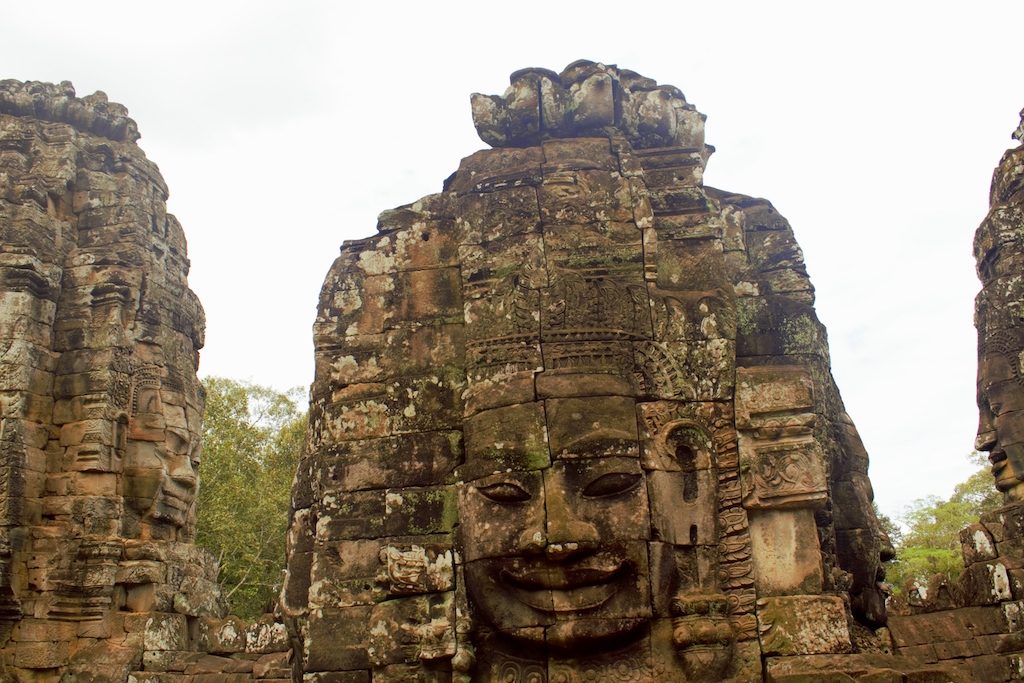
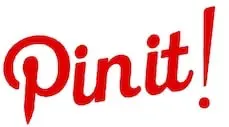


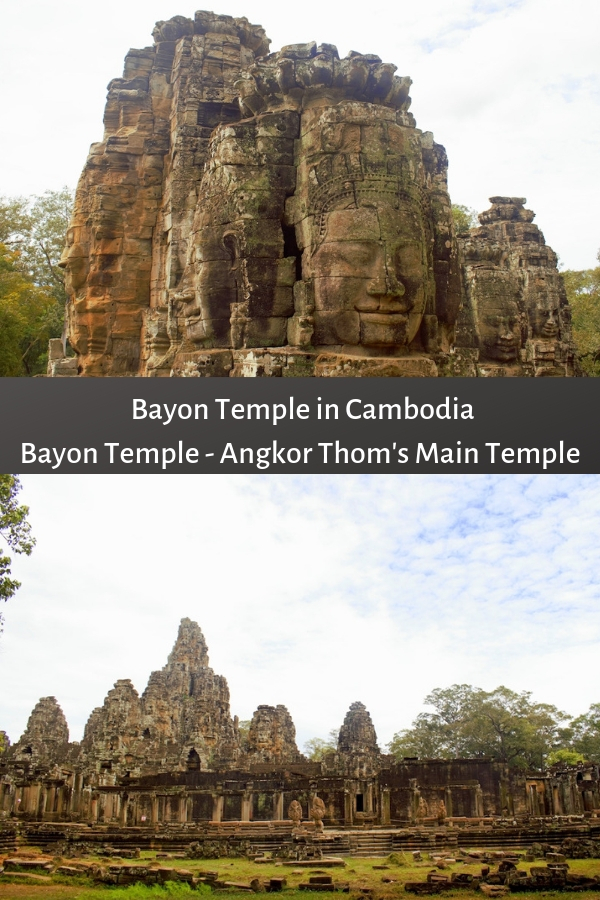
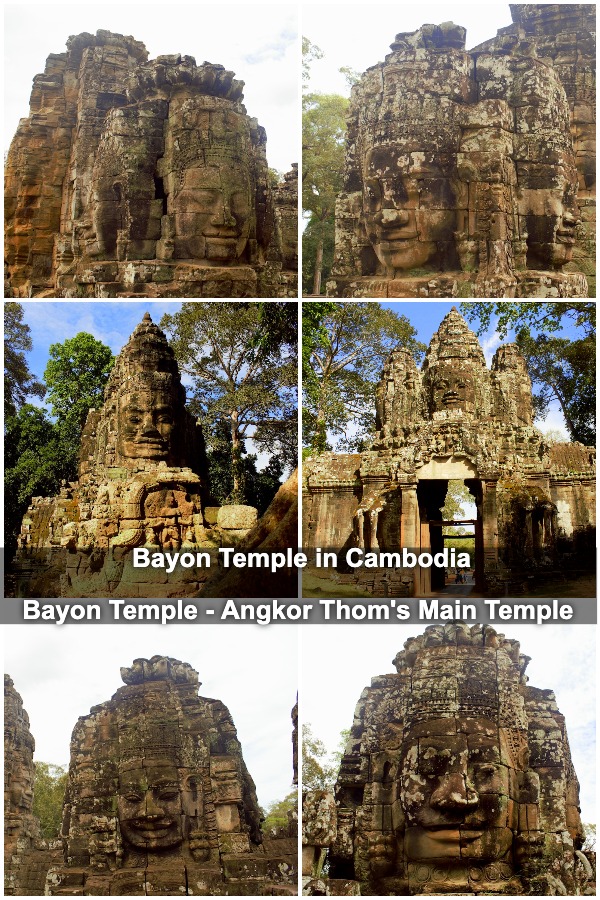

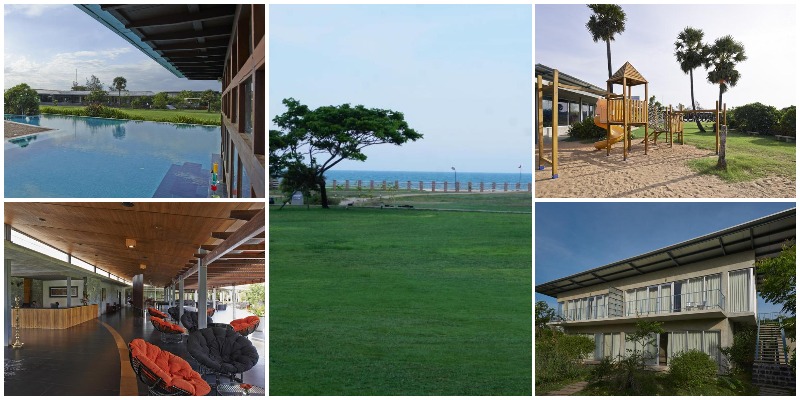
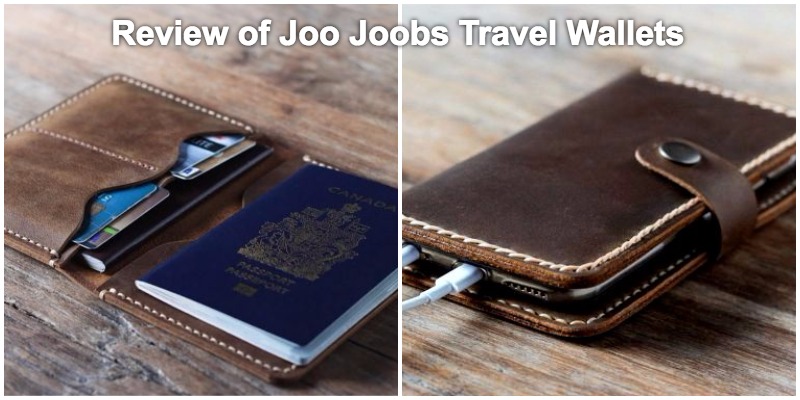

The article gave me so much information about the temple that I really do not need to look elsewhere to decide if i would like to visit this. Thank you for this!
Visiting Cambodia and the temples of Angkor is very high up on my list, so I’m happy every time I have a chance to read about these temples. The Bayon Temple looks indeed like a smiling face. I’ll probably hire a Siem Rep tour too.
Even though I had visited Angkor Wat and Bayon back in 2017, this was very informative indeed. Usually people just flock to the temples, get their photos clicked, and move on to the next destination. And as a result aren’t aware about the story, and history behind these structures.
Would like to visit bayon temple someday. There is so much to see and do here. The place is beautiful! 🙂
Woah, I learned so much about this place that I didn’t know – I just went and looked at the faces which were cool enough. Thanks for educating me. Ankor Wat and the Tomb Raider temple get all the publicity but this is probably my favourite temple in Siam Reap – I always love to think what the faces were thinking as they are so expressive.
I really like how you laid out this article, especially the FAQ section. Sometimes I already have specific questions in mind when I am planning a visit and I don’t have time to read through a million lengthy articles, but I really appreciate that you made a little FAQ section to get straight to the point about important things to know. Anyway, thanks for sharing. I look forward to visiting Cambodia one day!
Wow this is the most detailed and elaborate guide to Bayon temple that I have come across. I love all the historical facts that you have gathered. Looks like I won’t need to hire a guide if I read it once again before my trip to Cambodia. The mystry of the smiling faces is intriguing.
I have often wondered about visiting Angkor Wat, it’s been talked about for a long and I wondered about whether it is still as magical as it was rumoured to be. As per your photos, there doesn’t seem to be too many tourists, maybe it’s early in the morning… Thank you for a very tempting and detailed guide.
It would be awesome to be at the Upper Terrace of the Bayon Temple and see the 200 faces of the compassionate Bodhisattva.
Having visit the temples, I have to agree that the Bayon Temple in particular is a magical place. It was probably one of my favourites and this post brought back so really good memories. Thanks for sharing!
I was lucky to visit Cambodia a few months ago and it is definitely one of the top spots in Asia that you should visit. Thank you for sharing this information about the Bayon temple. I learned something new today.
I was, at first, excited when I heard you were visiting with a local guide and a diametrically opposed travel plan. Then I heard how you were visiting a obscure temple first, which seemed like a waste of the less travelled morning hours. I was relieved to know it was just means to an end of entering the North Gate and having a unique approach to the iconic Bayon Temple.
That’s an extensive information about Angkor Thom. I had been to Cambodia two years ago and I have visited this place for sure. I loved the Bayon Temple and the history related to it. Thanks for bringing my memories up fresh.
That’s beautiful! Are not there many films shot there?
I admit, I always associate temples with splendor and splendor and glitter. But these pictures show me that it is actually much nicer course. The faces that are seen there in the stone, seem so kind, so protective – just really nice!
I must say one of the main reasons why I want to go to Cambodia are these temples and your post only wants me want to get my tickets and fly away. The country has much more to offer than the temples but these stand out. The smiling faces of Byon Temple are the highlight for me. Would be better for an early start and would like to see sunset as well which would make it the picture perfect moment . Thanks for the detailed post
Cambodia has been on my mind but honestly I did not know much about the Bayon temple. It is truly enigmatic. The ramparts of the temple has so much to say about the history of the place and theses smiling faces of Buddha remind us of compassion and positive vibes.
Those faces are indeed serene. What a magical and mystical place the Bayon Temple is. I am so curious about Angkor Watt but I always read how crowded it is. Love that you found serenity amongst the stunnng faces. Shooting back up the bucket list!
From afar it really does just look like a big mass of rocks, but when you get closer the faces are really interesting. The different theories of who the faces of Bayon are seems like it will always be a mystery since there is more than one story.
I have to visit Cambodia very soon and loved reading your post. Bayon temple looks magnificent but also interesting as it is 12th century temple.
I like how you focused on these faces as the highlight of your visit. You are right that they are enigmatic and intriguing, they just make me want to not look away! It must’ve been quite an experience to see them in person.
Cambodia looks so magnificent. Your pictures are great! It has been on my bucket list since seeing a presentation by Patricia Schultz about her favorite places with an emphasis on Cambodia and Vietnam.